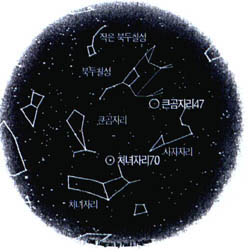중력파(波)를 탐지할수 있는 기구를 설계하는 것은 가능한 일일까?
알버트 아인슈타인의 이론에 따르면 중력하는 존재해야만 한다. 그러나 존재한다 하더라도 중력파는 너무 약해 과학자들은 이제껏 그것을 찾아낼수 없었다. 과학자들은 그렇지만 노력을 계속하고 있으며 언젠가 성공할 것 같다.
중력파를 찾아내지도 못하면서 그것이 있다는 것을 어떻게 알 수 있을까? 아인슈타인은 1916년 일반상대성이론을 창안해 내었으며 물질의 존재방식이 우주를 왜곡했고 그로인해 중력이 생겨났다고 밝혔다. 우주에서 물질이 재분포될때마다 왜곡의 상태가 변하며 이는 하나의 혼돈상태 즉 중력파를 만들어내고 이 중력파는 빛의 속도로 모든 방향으로 퍼져나간다는 것이다.
천문학자들은 이제 일반상대성이론이 옳다는 것을 완전히 믿고 있다. 그렇다면 중력파는 틀림없이 존재해야 하는 것이다. 예컨대 지구는 태양을 돌면서 중력파를 내 보내고 있어야만 하는 것이다. 이 과정에서 지구는 에너지를 잃어가며 점차 태양을 빙빙돌면서 안쪽으로 빨려 들어간다는 것이다.
이런경우 우리는 왜 중력파를 검출해내지 못하고 있는가? 대답은 중력은 우리가 아는한 가장 약한 힘이라는 것이다. 원자들을 묶고있는 전·자기력은 중력의 ${10}^{39}$배 만큼이나 강하다. 우리가 중력의 존재를 의식하고 있는 이유는 지구는 거대한 물체이며 그것의 무수한 입자들의 인력이 무언가 가시적인것을 추가하고 있다고 생각하고 있기 때문이다.
중력파는 가장 약하고 가장 얇으며 우리가 탐지할 수 있는 어떤 효과도 만들어 내지 않는다. 중력파때문에 지구가 잃고 있는 에너지양은 너무 적어 수십억년 동안 지구가 존재해 왔지만 아주 조금만 태양에 접근했을 뿐이다.
자연히 질량의 역동적인 재분포는 보다 큰 중력파를 만들어 낼 것이다. 하나의 별이 붕괴, 블랙홀로 되는 것이나 또는 두개의 별이 충돌하는 것과 같은 진정 거대한 물질의 재분포는 탐지하기에 충분한 큰 중력파를 만들어 낼 것이다. 이런 경우 검파기는 우주의 이곳 저곳에서 발생하고 있을 정말 거대한 재난에 대한 정보를 제공할 수 있으며 이 정보는 우리가 다른 방법으로는 얻기 어려운 것이다.
지난 1960년대에 매릴랜드대학의 과학자 '조셉웨버'는 중력파를 탐지하려고 했다. 그는 큼직한 알루미늄 실린더를 사용했다. 중력파가 실린더위를 지날 경우 실린더는 원자폭(幅)의 1백만분의 10의 크기로 수축 또는 팽창할 것이다. 그렇지만 가장 큰 중력파라면 검출하기에 충분한 크기로 실린더를 수축시킬 것이다.
실제 검출된 것이 중력파라는 것을 확실히 하기 위해 '웨버'는 두개의 실린더를 이용, 하나는 매릴랜드주에 다른 하나는 일리노이주에 장치했다. 중력파는 매우 길고 얇기때문에 전지구에 걸쳐 있게 되고 두 개의 실린더에 동시에 영향을 주리라는 생각에서 였다. '웨버'는 중력파를 찾아냈다고 생각했으며 잠시 과학계를 상당히 흥분시켰다. 그러나 다른 학자들은 이 실험을 되풀이 할 수 없었고 웨버가 중요한 일을 했지만 그의 실험도구는 이 실험을 해낼만큼 충분히 정교하지 않았다는 느낌을 갖게 되었다.
그러나 과학자들은 단념하지 않았다. 일반상대성이론의 진리를 증명하고 먼거리에 걸친 대사건의 속삭임(중력파)을 찾아내기 위해 그들은 새로운 '중력 망원경'과 씨름하기 시작했다.
이런 망원경을 위한 하나의 희망찬 설계가 스코틀랜드 글라스고 대학의 '짐 하우'가 이끄는 팀에 의해 고려되고 있다.
이 도구(망원경)는 직각으로 된 두개의 진공관(모든 공기를 빼 진공상태가 된 관)으로 구성될 것이다. 각개의 진공관에서 레이저광의 빔이 앞뒤로 1천여번 반사될 것이다. 진공관이 완전히 방해를 받지 않는다면 광파는 완벽하게 남아있게 될 것이다.
그러나 만약 하나의 중력파가 진공관들을 스쳐가면 한개의 진공관은 다른 진공관보다 아주 조금 수축할 것이다. 그리고 레이저빔을 흔들리게 할것이다. 이런 현상은 탐지될수 있으며 이는 중력파를 찾아낼수 있게 할뿐 아니라 그것의 에너지양을 측정하고 무엇이 에너지를 생성시켰을 것인가에 대한 약간의 정보도 얻게 해줄것이다.
현재 글라스고팀은 10m씩이나 되는 진공관들을 붙들고 레이저빔을 조사하기 위해 애쓰고 있다. 전망은 희망적이지만 그들이 중력파를 찾아내기 위해서는 길이가 1km나 되는 진공관들을 필요로 하게 된다. 이런것을 만들어내려면 2천5백만 달러나든다.
더욱, 실험을 제대로 하려면 전세계에 걸쳐 놓을 장치가 네벌이나 있어야 한다. 그래야만 네벌이 거의 동시에 중력파의 영향을 받게 된다. 이것이 확인되면 영향을 주는것은 중력파이며 다른 어떤것도 아니라는 것을 확신할수 있다. 검파시간에는 작은 차이가 생길 것이다. 그것은 중력파가 지구의 한쪽 끝에서 다른쪽 끝까지 갈때 빛의 속도로 진행하므로 1초의 23분의 1시간이 필요하기 때문이다. 그런 시차를 검토함으로써 중력파가 오는쪽으로 방향을 잡는게 가능해 질수 있다.
이 연구팀은 이런 거대한 실험을 하기 위해 모금을 하려고 노력하는 중이다.
Is it possible to design an instrument that can detect gravity waves?
According to Albert Einstein's theories, waves of gravitation should exist. But if they do, they are so faint that scientists have never been able to detect them. They are still trying, though, and they may make it.
How do we know they're there if we can't detect them? Einstein worked out the general theory of relativity in 1916 and showed that the presence of matter distorted space, resulting in the gravitational force. Every time matter is redistributed in space, the nature of the distortion changes and this produces a disturbance-a "gravitational wave"―that spreads outward in all directions at the speed of light.
Astronomers are quite certain by now that general relativity is correct, so that these gravitational waves must exist. The Earth must give them off as it turns around the sun, for instance. The Earth loses energy in this way and therefore is spiraling gradually inward toward the sun.
In that case, why don't we detect these gravitational waves? The answer is that gravity is by far the weakest force we know. The electromagnetic force that holds atoms together is a thousand trillion trillion trillion (CQ) times as intense as gravitation. The only reasion we're so aware of gravitation is that the Earth is an enormous body and the gravitational pull of its myriads of particles adds up to something noticeable.
Gravitational waves are therefore the weakest and shallowest waves that exist and they simply don't produce any effects we can detect. The amount of energy Earth loses by gravitational waves is so tiny that even in its billions of years of existence, Earth has spiraled inward toward the sun only a trifling distance.
Naturally, more energetic redistributions of mass will produce stronger gravitational waves. A really massive redistribution such as the collapse of a star into a black hole, or a collision of two stars, might produce gravitational waves just strong enough to detect. If so, a detecting instrument can give us information about the really great catastrophes that may be taking place here and there in the universe-information we might get in no other way.
Back in the 1960s, a scientist named Joseph Weber at the University of Marryland tried to detect gravitational waves. He used large aluminum cylinders. If a gravitational wave swept over it, a cylinder would compress and expand by a distance of about a ten-millionth the width of an atom. Nevertheless, the strongest gravitational waves might produce a compression just large enough to be detected.
To make sure whatever was detected actually was a gravitational wave, Weber made use of two cylinders, on in Maryland and one in Illinois. A gravitational wave would be so long and shallow it would encompass the entire Earth and should affect both cylinders simultaneously. Weber thought he detected the waves and for a while there was considerable excitement. However, others could not repeat the experiment and the feeling was that while Weber did important work, his instruments just weren't quite delicate enough for the job.
Scientists won't give up, however. The desire to have another demonstration of the truth of general relativity, and to be able to detect whispers of great events in the distance, keep them working on new "gravitational telescopes."
One hopeful design for such a "telescope" is being considered at the Universtiy of Glasgow in Scotland by a team under Jim Hough. The instrument would consist of two evacuated tubes (tubes from which all the air has been removed, creating a vacuum) at right angles. In each tube, a beam of laser light would be reflected back and forth a thousand times or so. If the tubes are comletely undisturbed, the light-wave will remain in perfect step.
If a gravitational wave sweeps over the tubes, however, one tube would be compressed a very tiny bit more than the other, and that would throw the laser beams out of step. This could then be detected, making it possible not only to spot a gravitational wave, but to estimate its energe content and obtain some information as to what might have produced it.
Right now, the Glasgow people are working with tubes that are each 10 meters long, just to test the workings of laser beams. Things look hopeful, but what they will need eventually, if they are to have a chance of detecting gravitational waves, are tubes about a kilometer long. Such an instrument would cost about $25 million to produce.
What's more, to do it properly, there should be four such instruments distributed over the whole world, so that all four would be affected almost simultaneously. That would make it certain it was a gravitational wave and not something else. There would be tiny differences in the time of detection, since it would take the wave about one-twenty-third of a second, moving at the speed of light, to pass from one end of the Earth to the other. By working with such tiny time discrepancies, it might be possible to locate the direction from which the waves are coming.
The researchers now are in the process of trying to raise the money for such a large undertaking.
(c) 1989, Los Angeles Times Syndicate
1989년 09월 과학동아 정보
🎓️ 진로 추천
- 물리학
- 천문학
- 컴퓨터공학
















